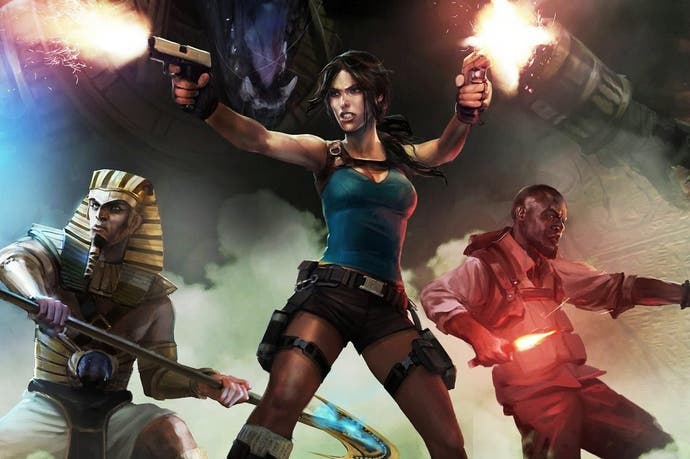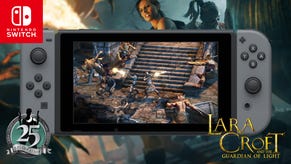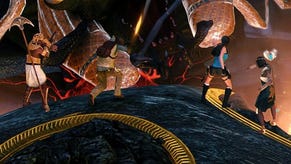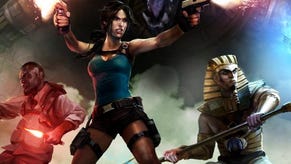Lara Croft and the Temple of Osiris review
Get set.
When the god Osiris was murdered by Set, his body was lopped into pieces and scattered across the land. This was bad news for Osiris, but it was good news for game designers. And look at this: several thousand years later, here's a new Lara Croft adventure in search of a handy structural conceit. What's your reward for completing this level? Well done: your reward is a foot. Now, see if you can find the rest of the body. Go!
Maybe Osiris isn't the only one who finds himself fragmented these days. In Crystal Dynamics' big budget Tomb Raider games, Lara is a victim of some serious Nolanisation. She bleeds as she scrambles over rocks, she cries about all the wolves she has to kill with her bow and arrow, and the best she can hope for at day's rest is the chance to suffer afresh tomorrow morning. A cut-scene throws in an aside explaining that this new, more human Croft used to work at the local boozer; maybe in the sequel we'll see her shopping for home contents insurance.
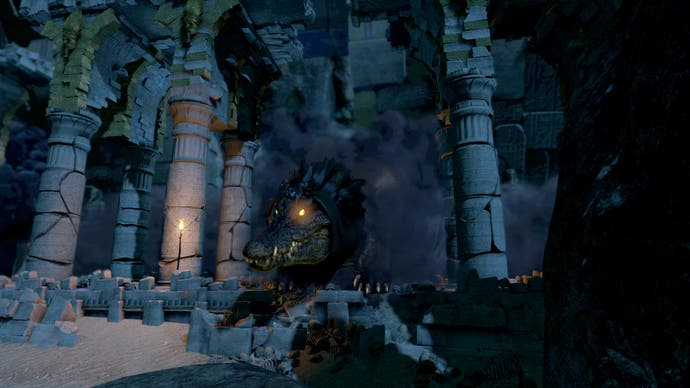
In the land of download games, however, the classic Lara is still at it, brutalising wildlife, turning ancient ruins to dusty shrapnel, and maintaining an interest only in that which glitters and shines. Med packs litter the sand and Keeley Hawes is doing her best Poppins impression in a soundbooth somewhere. Forget The Dark Knight treatment: Lara's bite-sized adventures are the equivalent of a Saturday morning cartoon, and they're the better for it.
If you're coming here from Lara Croft and the Guardian of Light, you should be right at home. The setting's switched to Egypt, with Lara dropped into a family feud between Isis and Horus (good) and Set (very bad), but the basic formula is unchanged. The action's still spread across a series of isometric levels that come packed with arcadey challenges. The moveset is largely unaltered, right down to the twin-stick controls for running and shooting, and a dodge roll to get out of trouble. On top of that, the whole thing remains a breathless rush between one classic Tomb Raider idea and the next: a gentle puzzle (generally involving rolling boulders about or dodging spikes), a quick burst of combat, and then some light platforming and a crazy race over treacherous ground that's just itching to drop away beneath you.
There are a few tweaks. Osiris' loot game is much better than Guardian's was, for example, with a Diablo-style character inventory screen that makes the differences between each perk-providing ring or amulet you pick out more immediately obvious. Every tomb you raid now concludes by dropping you into a treasure room filled with crates and chests, too. They'll reveal their secrets as long as you've collected enough gems to open them. This is hardly Diablo, but it's better than it used to be.
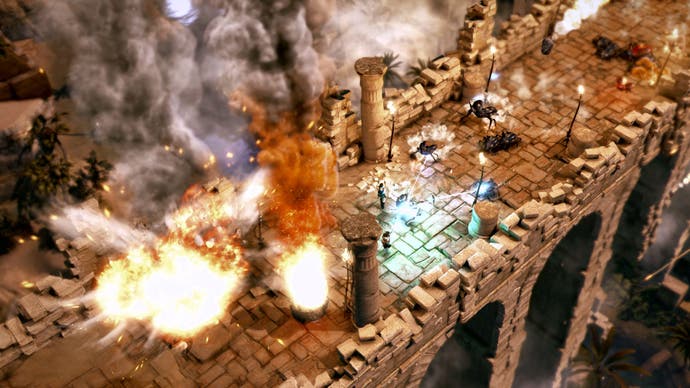
Elsewhere, Totec's spear from Guardian is replaced with a staff that fires a laser beam. Bit of a shame, this one: that spear was a classic. It offered plenty of nasty feedback once lodged in an enemy's windpipe, and it livened up traversal if used to create makeshift ledges. The staff, by comparison, sizzles quite nicely as it knocks foes back or blasts a path through some neat mirror-based puzzles, but it's not as pleasingly tactile to use as the spear. Equally, its ability to interact with very specific parts of the environment - raising platforms or slowing spinning cogs so that you can slip past without getting mangled - is a little too prescribed. You never feel clever. You never say: a-ha.
If you're partying up either locally or online, the game's arsenal is divided between players in interesting ways, Lara, or Carter (an archaeologist rival with little personality to speak of), getting control of a torch and the magnetic grapple hook, while Isis and Horus control the magical staff, along with the ability to summon an energy shield that can be used as a platform for allies. Co-op now allows four players to work together rather than two, and the levels even rearrange themselves in different ways depending on how many people are present. More adventurers means more taxing puzzles, basically - and they also give proceedings a wonderful jolt of energising cruelty as you barge friends out of the way to grab the best loot.
Everything works almost as well as it did before. New tech grants this rocky landscape a glorious solidity, along with improved character models and some really flappy hair (although the Xbox One code I played had a smattering of minor bugs ranging from glitchy animations to the odd event that wouldn't trigger, requiring a checkpoint restart). There's also a lovely pulpiness to the locations, from the Tomb of the Torturer, which is stained with a lurid blood-red light and littered with endless boobytraps, to the Tomb of the Ferryman, a balmy span of lakes and rivers where you encounter a species of crocodile that has learned to walk upright and lob grenades. (Crocodiles, it turns out, are no longer scary enough in their own right.) Osiris is a lot pacier than Guardian, too, flinging its various elements together so efficiently that the whole game can pass in a blur if you're not careful.

This is the only real problem, in fact: Osiris is so good at braiding its simple pieces together that it takes a while for you to notice that none of the individual parts of the game are truly first-rate. Combat's fun enough when the remote mines are exploding and the physics is kicking in, but it's built on a foundation of weightless weaponry and samey enemies. Platforming is given a juddery feel by ledges that are just a little too sticky in their eagerness to keep you safe. Puzzles, meanwhile, have been streamlined far beyond those in Guardian - a game which offered one temple, for example, in which you had to find eight boulders to fit in eight recesses, and as you fanned out in all directions you discovered there was a gimmick to getting each of them.
Still, The Temple of Osiris is a welcome throwback, and for the five or six hours it took me to barrel through the campaign, the rest of the world blinked away as the sands swept in and the ancient machinery started to turn. As with Osiris, I'm not sure Lara's reassemblage has gone entirely to plan, but the spirit remains intact - and the spirit is still strangely powerful.
